Six Take Home Lessons from Tour Divide

UnTapped co-founder, Ted King, recently went for a very long bike ride. A nearly 750 mile bike ride, in fact. His goal, however, was the 2,700 mile Tour Divide, a self-supported bikepacking race from Banff, Alberta, Canada to Antelope Wells, New Mexico at the border of the United States and Mexico.
By not reaching the finish line, this trip could be labeled as unsuccessful. There is still lots to be learned from unachieved goals and in searching for a silver lining, Ted recently wrote up a list of the six things he learned along his first attempt at the Tour Divide.
- Bikepacking is an all-encompassing job. Admittedly, “job” is a funny term for something that you’re likely doing voluntarily, but you get the point. At the most basic level, bikepacking is very simple – ride, eat, sleep, repeat. But there’s a constant shuffle of checking battery levels, recharging on the fly, any number of ways to obsess over the route, consider the demands of fueling, all on top of keeping inventory of things to change or tinker with when you do stop.
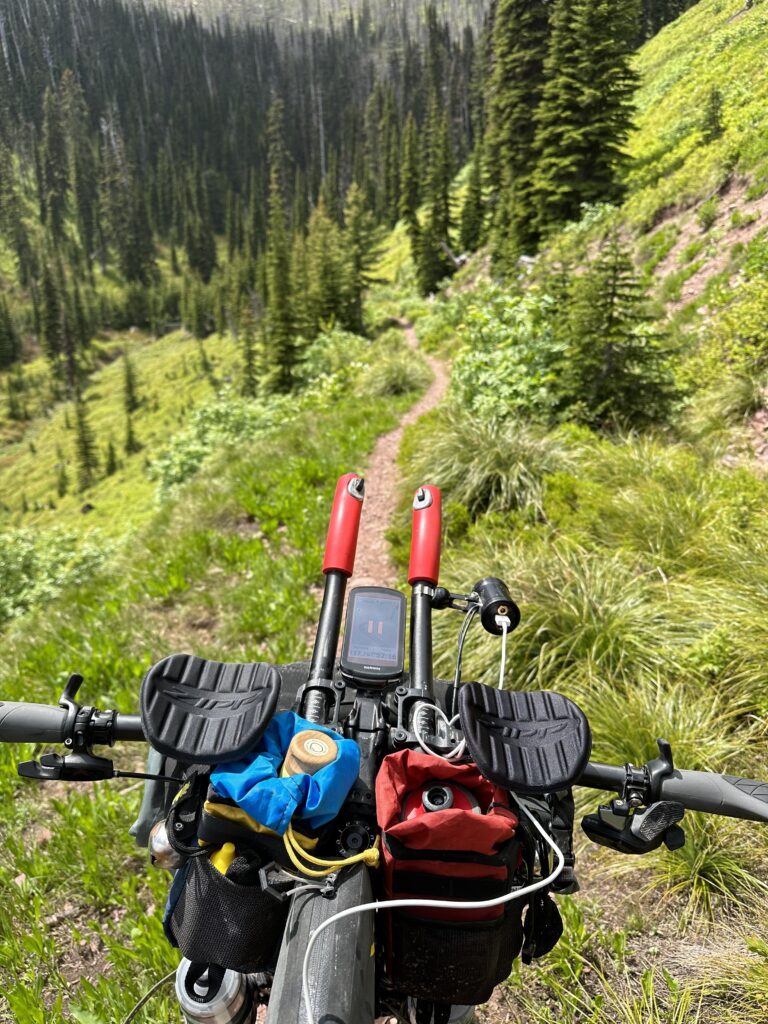
- Practice. Practice, practice, practice. A simple idea to absorb, but this is a much tougher one to pull off in… practice. There’s no better way to figure out how well your sleep system works or if your bags are fully waterproof or if your otherwise very comfortable shoes will cause your feet to hurt after multiple 12+ hour days unless you’re putting in considerable time on the bike. (The answers are: very well, not entirely, and yes, they likely will.) This tidbit is as helpful for training as it is for getting your mind wrapped around the rigors of all day, multi-day events.
- Nutrition presents its challenges . There are lots of reasons why nutrition is difficult. For one, as long as you’re pedaling, your body is consuming more calories than your digestive system can handle. So at the end of every day, you’re ending up at a deficit. Two, your bags and jersey pockets can only carry so much food! So be sure to design your bag system with room to expand for those times you need to carry 3,000-4,000 calories of food. Three, ingesting that many calories — just eating that much food — is not an easy task. That’s a combination of being a large quantity of food and because your diet is frequently put together at gas stations or fast food restaurants. I will point out that I paid particular attention to get my hands on real foods whenever I could. Sandwiches, burritos, yogurt, pickles, baked goods, and yes, nips of maple syrup whenever possible. You can only eat so many candy bars before they’re not so appealing any more.
- A 2,700 mile race is a marathon, not a sprint . Or more accurately, it’s a few more than 100 consecutive marathons. This is not in any way whatsoever news to me, but it’s so important that I find it worth repeating. I’ve done a 1,000 mile bikepacking race in the past and even that was a sprint compared to this. By that I mean, you can operate at a sleep deficit, a caloric deficit, an overall operational deficit for shorter events, but something this massive requires you to slow down, to sleep more (which in personal reflection is my biggest failing), to maintain all levels of hygiene that you can get away with cutting corners in shorter, faster events.
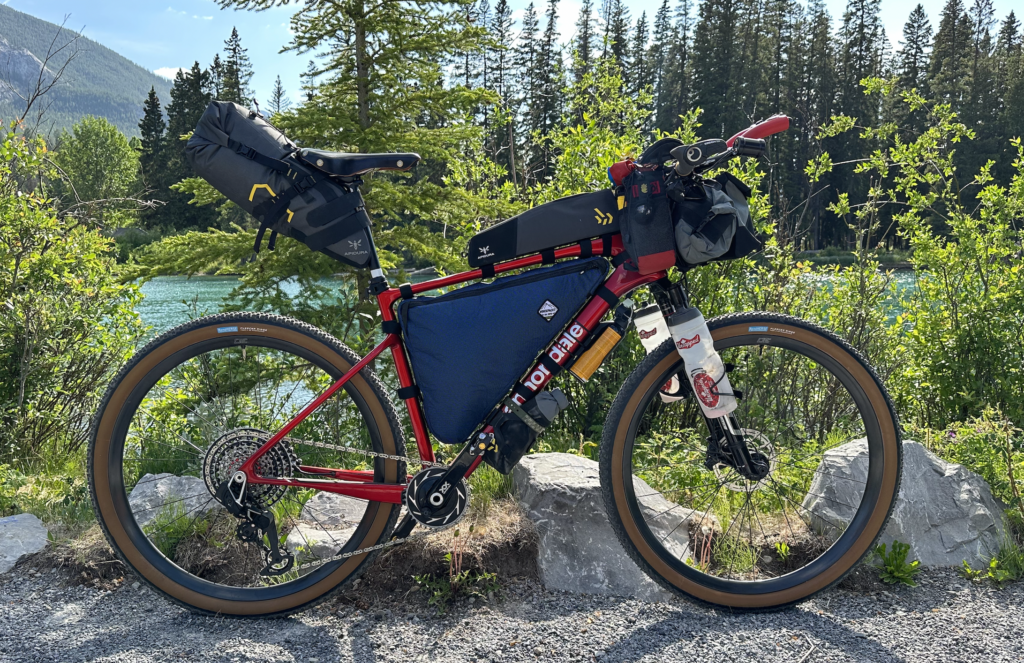
- Every once in a while, it’s nice to be out of your element. If you’re anything like me, the very first thing I do every single morning is find my way to the closest coffee-making contraption and make it do its thing. So quite frankly, I was more than just a tiny bit worried about how I’d operate waking up in the woods rather than within 50 feet of my coffee maker. My own bed is comforting, the ability to take a shower, to turn up or down the thermostat, those are all creature comforts that I know and adore, but I’m also equally happy to know I can live without them… on occasion, anyway. Furthermore, my coffee tastes that much better and my bed is that much more comfortable when I’m without it briefly.
- Once you start riding, (almost) all cares go away . Okay, scroll back to number one and you can see that I’m contradicting myself. But I wish I knew how peaceful all things become as soon as you start pedaling. All the previous woes regarding preparation that have kept me up at night are a thing of the past and it’s a very simple thing to move forward.

- Oct 2, 2023

King Of The Ride Podcast: Ted's Tour Divide
Episode 112: My [Ted King] Tour Divide Recap with Guest Host Rebecca Rusch

When was the last time you did something that really pushed your limits? That was less enter-the-dragon and more face-your-own-dragon?
Ted King took on the Great Divide Mountain Bike Route. During his expedition, he had to push himself to his ultimate limit.
Rebecca reached out to Ted about his journey because She knows what a big and transformative experience bike expeditions can be. It’s often hard to articulate how your mind, body, and heart feel afterwards. It’s hard to put it all into words.
So, She asked Ted if I could interview him to help with the process. He said yes!
Take a listen now! ⬇️
Recent Posts
The Depth of a Father's Impact w/ Rebecca Rusch on The Warrior Dad Podcast
Invited to the Party with Rebecca Rusch (Ep. 168) - Girls Gone Gravel Podcast
Celebrating a Year of Success
Welcome to Escape Collective. Please select your language.
Please note that this is an automated translation and it will not be perfect. All articles have been written in English and if anything appears to not make sense, please double check in English.
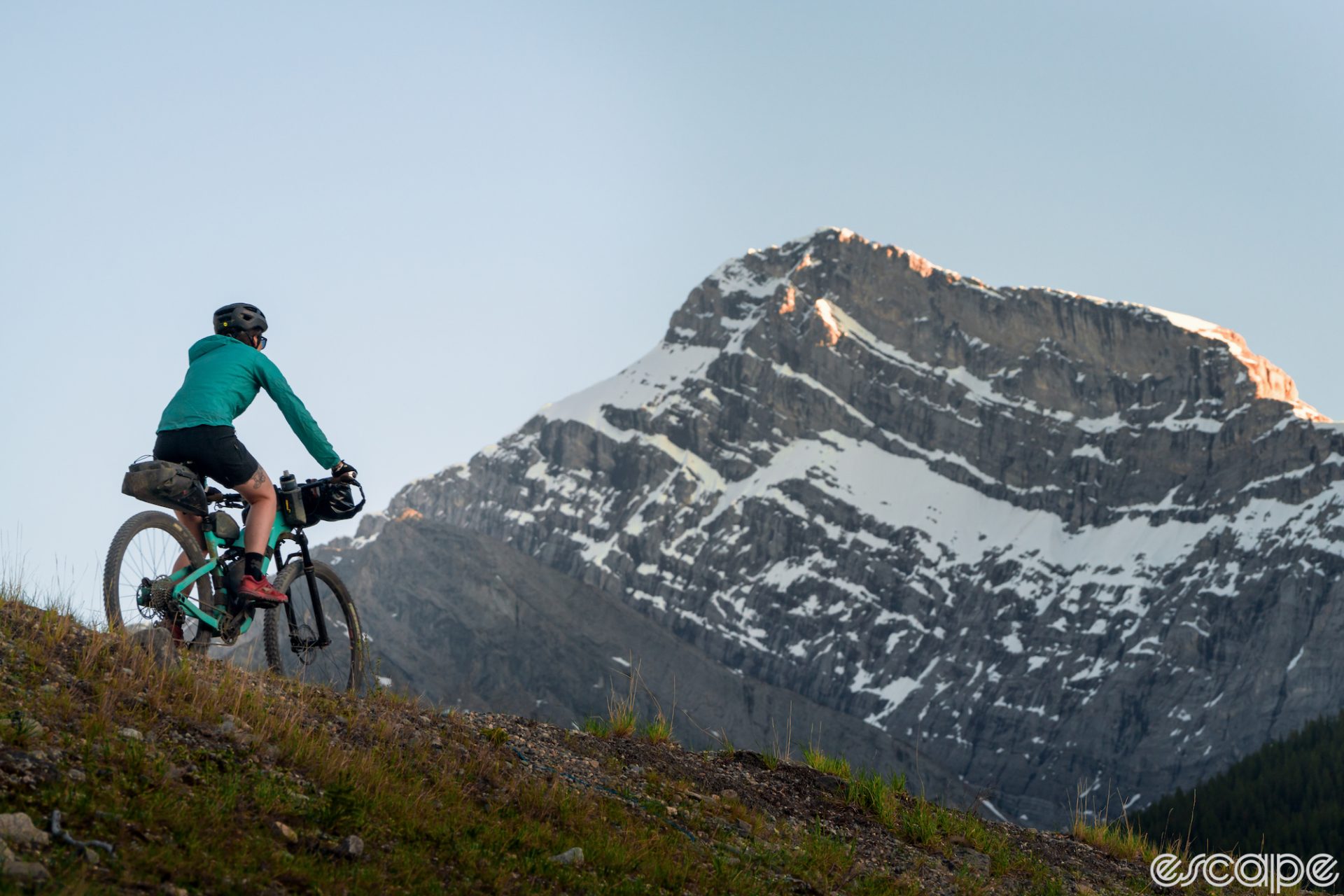
What do ultra-distance events like the Tour Divide do to the body?
A small but growing body of evidence suggests multi-day races create physiological changes to the body, some of them permanent.
Last June, a small group of bike racing fans was online eagerly following an event, as is often the case. But they weren’t watching the Critérium du Dauphiné or the Lenzerheide mountain bike World Cup. They were refreshing a webpage to follow 200 “dots” making their methodical way from Banff, Canada to Antelope Wells, New Mexico. Each dot was connected to a GPS tracker, carried by a cyclist, along with most of the gear needed to pedal 2,745 miles and climb 200,000 feet. Those cyclists were riding the Tour Divide–an event that entails biking for 2-4 weeks for 8-20 hours a day, subsisting on gas station food, and sleeping in the dirt.
The Tour Divide is both informal and highly anticipated, the start line is casual, there is no registration, no podium, and no entry fee. Riders agree to rules, such as not accepting help that anyone else couldn’t access – so they can check into a hotel or buy themselves a new rain jacket, but they can’t plan to have anyone meet them for support. The race runs on trust: “nothing to win or lose but honor,” as the rules outline. Given the informality though, this event draws in a global fan base and many international riders. It’s known for its ruggedness and holding a record or a win from this race is highly sought after in the world of ultra-endurance bikepacking.
We understand endurance sports come with benefits such as building strength, basking in those endorphins and pushing our perceived limits. But alongside this, most sporting events can also take a toll on our minds and bodies. An event like the Tour Divide, with its sheer distance and demands, brings this impact to another level.
Compared to the cycles of rest and recovery we are used to, what happens to a body when we choose to forgo recovery, almost entirely, for weeks on end? Physiologically, what’s happening and how do we measure if that impact is ultimately positive or negative for the body?
Ultra-endurance events are defined as any event that lasts longer than six hours. The Tour Divide laughs in the face of six hours. Six hours is a warm up for the next ten hours of riding that day, followed by another two weeks of the same pattern.
Barring the innumerable reasons a rider might drop out, these athletes can expect extreme exhaustion often paired with hallucinations, repetitive-use injuries, and a deep disruption to most systems of their body. Even when this event goes well, riders are steadily depleting themselves for weeks on end. The line between “going well” and not is thin, and can have profound, long-term effects on the body. But for a small group of hardy souls, there’s an irresistible draw that keeps them coming back.
The quiet before the long storm
Before starting a race like the Tour Divide, riders want to strike a balance between fitness and rest, knowing that they have done everything they can to be physically and mentally prepared for incredibly long days. For most Tour Divide athletes, their preparation and foray into endurance sports started years before they reached the start line. They have accumulated thousands of hours of pedaling and learning what their body and mind are capable of. Zoe Caliendo, a physical therapist and cyclist from Reno, Nevada says, “There’s so much focus on the ride itself but the real work comes from the year or years before.”
Two-time Tour Divide rider Hannah Dhonau says that in this long of an event, “The stakes feel higher. There’s a lot we can put up with for three days that we can’t put up with for two-plus weeks. So my focus was having a durable body. I wanted to ride a lot and ride when it wasn’t comfortable, whether that’s temperature or terrain. ‘How is this going to feel if it’s gritty? Or if it’s really hot?’” To train for that, Dhonau rode at unusual times of day, practiced riding at night, and left the house when no one else would think to ride.
More than even most bikepacking events or rides, conditions can change dramatically on the Tour Divide. This year, riders faced torrential rain, huge stretches of mud, ridiculous heat waves, and incredibly persistent head winds. Knowing how your body responds, how your gear works, and what you need to take care of yourself among such variability is key to maintaining momentum. Participants who had taken time to mentally and physically prepare for this type of adversity absolutely fared better.
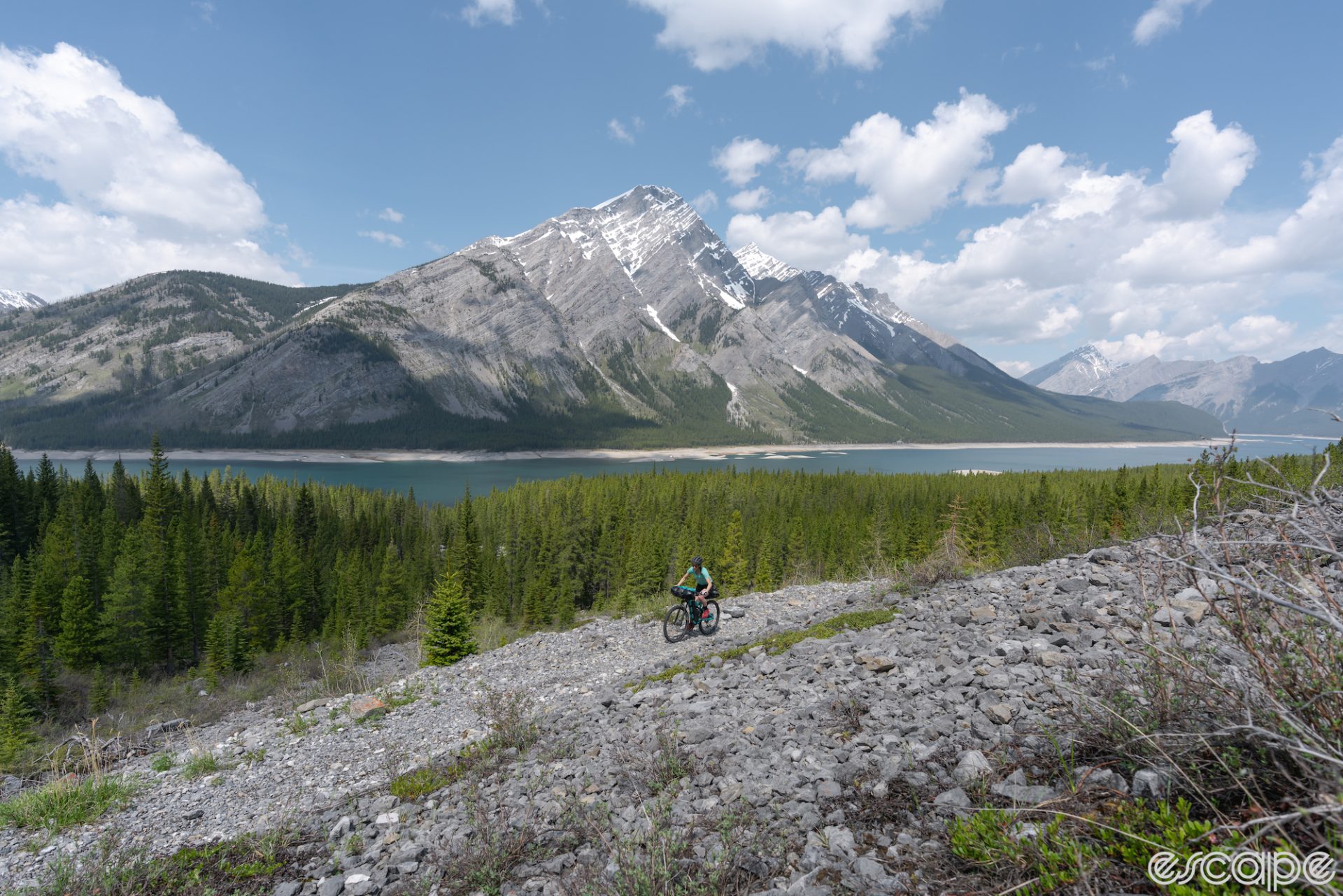
The rigor of repetition
One of the obvious tolls of this ride is on the muscular system. The Tour Divide is a race of steadily moving at a relatively slow and sustainable speed. Riders will often say that even moving one mile an hour is better than stopping. The intensity is low, but the sheer duration of time spent moving forward is high.
Caliendo says that when we use our muscles, say in a gym setting, we create “micro damages and inflammation when we exercise.” This damage is repaired when we rest. When the muscle repairs itself, it can grow back stronger. So, after a big day of squats, you’ll leave the gym with tears in your muscles. Then, the time you spend sleeping or resting is when your muscle will repair itself and actually grow stronger.
Eliska Albrigtsen, an athlete and collegiate running and ski coach at the University of Alaska Fairbanks, adds that, “Normally we want inflammation in the muscles, it brings us strength in the end, as the muscle fibers break, they bring in inflammation which washes the weak muscle fibers out and new muscle fibers have space to grow and increase.”
We’re talking about [pedal] revolutions on a bike; it’s very one-dimensional and linear and repetitive. -Zoe Caliendo
At an event like the Tour Divide though, recovery time is incredibly limited. Albrigtsen says, “Recovery is barely there so you do have to rethink how to approach it.” A small 2022 study of ultrarunners in an 11-day, 768 km event found elevated markers of muscle damage didn’t subside until nine days after the racers finished.
One of the 2023 Tour Divide’s fastest starters, former WorldTour road pro Ted King, ultimately dropped out of the race after experiencing the extreme end of muscle damage. Although King is an exquisitely fit elite athlete with lots of experience with the intensity of road racing, he’d done few multi-day ultra endurance events where – without the structure of stages – it’s up to each rider to decide their own 24-hour pacing and rest strategy. His approach was different to other riders: he planned to ride a harder pace, but stop about eight hours per day.
But after day four, he encountered what felt like “the ultimate bonk,” he recalls. “Just uncharacteristically empty.” He got dizzy on the bike and had a pulsing headache, and felt oddly bloated. “There was a strange puffiness under my eyes and my whole body was kind of swollen,” he says. A quick phone consultation with a friend who’s a physician sent him backtracking to Butte and the nearest hospital. King took some tests and was told he had rhabdomyolysis, (often called rhabdo) where damaged muscle tissue releases large amounts of proteins and electrolytes into the blood – a process that can cause severe damage to the heart and kidneys.
That highlights a unique risk of ultra racing. Our muscles recover with rest and intentional fueling, but ultra-racing’s self-paced structure puts riders in the position of making choices that may damage their health. Riders like King pushed themselves to exhaustion, causing severe muscle damage in an environment with limited access to high quality fuel and incredibly limited rest. Of note, another study of ultrarunners , from 2018, found signs of acute kidney damage, even though runners reported no clinical symptoms. King, thankfully, recovered with no long-term effects – in large part thanks, he thinks, to a vacation immediately after his Tour Divide experience that saw him off the bike for several weeks. He’s still unsure of his future ultra-racing plans.
King’s experience was unusual. But even for well-trained riders who avoid acute injury, Caliendo pointed out that the toll on the muscular system still adds up because “we’re talking about revolutions on a bike; it’s very one-dimensional and linear and repetitive.” Unlike other sports which may require more dynamic movements and bring in additional muscle groups, cycling is locked in. Our feet and hands stay in position and the motion is meditatively, or mind-numbingly, similar, often resulting in repetitive use injuries in addition to extreme muscle fatigue which will last for days or weeks after the event.
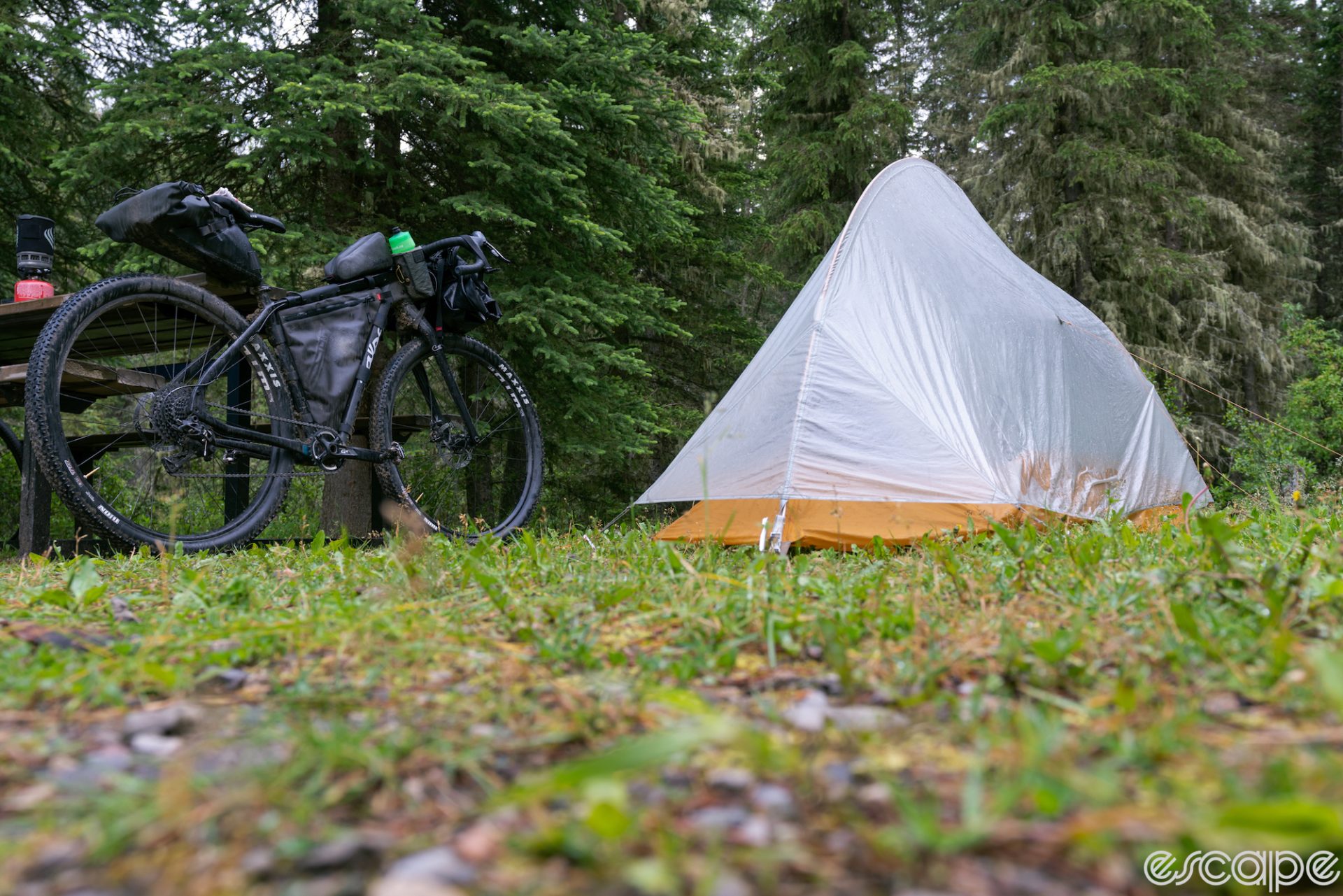
The heart of the matter
Our cardiovascular system consists of our hearts, blood, and blood vessels. When we exercise our heart rate increases, pumping more blood and energy to our cells to keep up with the exertion. During the Tour Divide, the steady pedaling movement elevates the rider’s heart rates for hours on end. While they are never sprinting or reaching a maximum heart rate, the consistent increased heart rate can have significant impacts.
Within cycling, most athletes and coaches use a model of five or six training zones based on heart rate and power. Zone 2 is similar in both of these models and constitutes the heart rate and power you can sustain for three hours. For heart rate, this number is based on your maximum heart rate. For most riders, this max HR number is somewhere in the range of 165-185 beats per minute (bpm). Zone 2 is defined as 60-70% of this number. So, for an athlete to keep their heart rate in Zone 2 they might aim for 100-130 bpm for the majority of the ride.
Moving outside of Zone 2, as Caliendo explains, means you’re breaking down more glycogen in your liver and in your muscles which increases your risk of bonking and changes your fueling needs.
The format of the Tour Divide can make this challenging. Caliendo points out that, “It could be really hard to stay in Zone 2 for long periods of time, day after day, because your body is working increasingly harder to stay there. Zone 2 pace on day two of this ride and Zone 2 pace on day 13 of this ride are going to look different. Your body is working so much harder to keep that pace.”
Additionally, the rider’s resting heart rates will increase during this event, indicative of the lack of recovery. “The reason your resting heart is higher is your body is working harder to heal from that effort. When you have days and days on top of that, your resting heart rate is increasing and it is actually harder to stay in lower heart rates because your resting rate is already up.”
Again, even when this ride goes well, the cardiovascular system takes a hit as it works overtime for days on end. Studies of ultra-endurance athletes suggest that long-term ultra-endurance exercise can create permanent changes in cardiovascular function, including myocardial fibrosis, or a scarring of muscle tissue in the heart. What’s more, most of the research is on ultrarunners in shorter events: 50 km to 200 km. There’s almost no scientific literature on weeks-long races where athletes are putting in 18-20 hours a day of effort.
Running on whatever fuel you can find
Since rest is so limited, fuel becomes extra important. However, this event also strips riders of access to most high quality food. It would be incredibly heavy and cumbersome to carry enough food for 2-4 weeks of riding, so participants stop at rural gas stations, maybe an occasional grocery store, or, if they dare, take a lavish break to actually sit down at a restaurant for a meal.
Some riders will carry energy bars they prefer, protein powder, or some dehydrated meals. For the most part though, this extra weight is deemed unnecessary and participants rummage through gas stations and hope their high-metabolism bodies can act like garbage disposals and eat up anything they can get down.
The recommendations for ultra endurance events (broadly defined as any event longer than six hours) offers some insight into the massive fueling needs on the Divide. Study after study finds that most athletes are under-consuming carbohydrates both before and during an event. For endurance events, researchers recommend that an athlete’s carbohydrate consumption sit around 90 g per hour. Leading up to the event, athletes are best positioned if they consume 10-12 g of carbohydrate per kg of body weight per day for numerous days before the event. The math becomes a bit nauseating, but if a 70 kg athlete aims to sit between this range of preparation for the next days and fueling needs for their current effort, they could be aiming to consume anywhere between 700 and 2,000 g of carbohydrates a day. For reference, an entire 14-inch pizza contains around 300 g of carbohydrates.
It’s pretty evident that replacing those energy stores through food alone is an almost hopeless battle. When asked about fueling, Dhonau says, “The whole event feels like an eating contest which is exhausting in its own way.” Not only is food availability limited, the sheer amount of calories, macronutrients, vitamins, and electrolytes these riders need is daunting. Eating requires significant attention, doing so while pedaling and minimizing stops only adds to the challenge.
Dhonau said, “I ate a ton of bars and candy and Pop-Tarts, so many Pop-Tarts, and whatever real-ish thing I could scrounge up. A lot of French fries, that kind of thing.” Lael Wilcox, the winner of the 2023 Women’s geared race this year, is known for downing half gallons of milk while sitting on the curb of a gas station. This event, again, forces us to rethink the complicated science around fueling and, instead, orient around the best-we-can-get in sub-optimal conditions.
Most riders, as they shove their pockets full of Snickers, are not considering the complicated manner in which our bodies access energy. The shortest burst of energy, like a hard throw or a five-second sprint, runs off of the phosphagen system, an anaerobic system which utilizes creatine phosphate and replenishes in a matter of minutes. For efforts which last a few minutes or less, the body primarily utilizes the glycolytic energy system, or the anaerobic lactate system, which runs on glucose (simple sugars) for fuel. For longer efforts, we run primarily on the oxidative, or aerobic, system, which uses carbs and fats in varying ratios. Our body moves in and out of each of these energy systems depending primarily on the time we’ve spent exercising and the intensity of exercise.
During extended exercise, we can run out of glycogen stores. At this point, our body will start making glucose from non-carbohydrate sources, a less-efficient and sometimes detrimental process. While we use all three energy systems simultaneously, the ratio and role of each depends on intensity and duration. Broadly, Albrigtsen explains, “You first burn carbs and sugars, then fats, and when the storages are depleted, your body starts taking your muscles apart for energy. Riding for two weeks will be digging into all of those energy storages at some point, which makes it important to replenish all of them. “Sugars are pretty easy to replenish if you eat every hour or so,” she says, adding that it’s far harder to ensure you’re getting enough fat and protein.
In order to keep moving day after day, riders have to somehow find enough quick carbs and sugars as well as enough quality fats and proteins. Folks will shove burgers in their pockets, spend $50 on gas station snacks for the day, continually eat gummy candy, or sit and drink multiple Gatorades on the side of the road.
The trick is to find the calories and hydration that will not hurt your stomach and are quick to eat – with bonus points for nutritional value. Riders also think about minimizing the food and trash they need to carry when they start riding again. The reality is this is a nearly impossible balance to strike and caloric deficit is nearly unavoidable, further minimizing recovery.

The physical and mental limits
Riding for up to 20 hours a day means sleep deprivation is inevitable. Caliendo says, “Sleep is kind of the base of health. Everything kind of sits on sleep.” If the amount of riding wasn’t enough, the lack of sleep compounds every challenge riders face. Of note, a 2022 study of ultrarunners published in Frontiers in Physiology – which also looked at cardiovascular function – found significant deterioration in cognitive abilities: not only did memory decline, but reaction times increased by 30 percent on average, and athletes were similarly delayed in decision-making tests.
As Caliendo says, “Lack of sleep is going to affect memory, your self-control, your decision-making. And as you add fatigued muscles which is going to decrease your balance, your proprioception, your ability to react.” Additionally, Caliendo points out that such extreme fatigue will affect blood sugar management, certain hormone cycles, and our immune system function. Each of these systems will settle back to normal, but riders can expect this process to take significant time after the event.
Dhonau says that she planned to sleep around four hours a night for races as long as the Tour Divide. She notes that the fatigue is intense to adapt to: “At first everything feels so hard and I felt like my body just hated it. Then I got to a spot where I was really fit but not too depleted. Colorado, for me, felt great. There’s a sweet spot where I felt really fit and the cumulative fatigue didn’t feel as terrible. By the end though, I was so tired but also had my systems dialed. I knew exactly what I needed at the gas station, I knew exactly what to do every time I stopped. In some ways autopilot took over, so I was doing it but my body definitely wanted to stop soon.”
Everything just feels more acute – emotions just feel so much bigger. -Hannah Dhonau
Beyond even the physical demands of the race, the mental demands may be an even tougher beast to slay.
One study , published in PLoS One, looked into the mental toughness of ultra endurance athletes – in this case ultra runners competing in a 100-mile trail run, still a notably shorter event than a race like the Tour Divide. However, researchers found that athletes who entered this event self-reported significantly higher rates of self-efficacy and mental toughness than athletes who competed in shorter distance events. Interestingly, higher rates of self-efficacy and mental toughness did not have significant impacts for where a competitor placed within the field or even if a competitor would finish the race, implying that there is a threshold of mental strength to get an athlete to the start line, but past that point, other factors are likely more influential.
Caliendo agreed, saying, “The mental resilience is probably one of the most important pieces for these riders. There is going to be a lot of pain and discomfort, you’re going to want to crawl into a bed. That mental resilience is really what you need to even train for a ride like this.”
Even when things are going fine, emotions can feel magnified. Dhonau notes how wild it was to be with her thoughts for weeks on end with not much more to do than pedal. “Everything just feels more acute – emotions just feel so much bigger,” she says. “Joy and frustration and everything just feels big.”
An obsession, healthy or otherwise
So with all that, are extreme ultra-distance races like Tour Divide good for us, or should we be more aware of its potential for harm? This type of endurance event offers a space of both/and, both knowing that sleep deprivation is bad and continuing forward, both tuning into what you need to eat to optimally refuel and recognizing you have to compromise in that 7-11 at midnight, both understanding when you absolutely must sleep and pushing to this very edge, both recognizing and fixing physical problems and crossing your fingers that they might just go away on their own if you’re lucky.
Both physically and mentally, in a race like Tour Divide the body becomes the vehicle and the driver, push-pulling along the entire Continental Divide. Riders fight the elements; battle deep physical, mental, and emotional fatigue; injury; gastrointestinal distress; and still feel the draw to continue, fueled by a profound mental toughness. That changes riders for the long-term, and it’s an open question how much of that is good versus not.
Despite the continual narrative that sports are beneficial, riders like Dhonau know that the physical effects are likely detrimental for overall health and longevity. Body systems protest for days on end, even after finishing. Pushing to the point of hallucination, severely limiting recovery, and remaining fixed in one pedaling position for weeks is a huge feat that also comes with negative health ramifications.
And yet, for a small group of hardy souls, they are continually drawn to it. As King observes, only a few percent of the entrants in a race like the Tour Divide (or even Unbound) are lining up with thoughts of winning it. “The rest are there for reasons to prove something to themselves,” he says, “to see if they can make it to the finish line” basically. And once they do, “the majority of people want to do it again, and challenge themselves to do it faster, to improve.”
The Tour Divide may be an entirely different kind of event, but it’s still a competitive one, even if that competition is only with ourselves. Once we release the expectation that something like the Tour Divide is solely good for us, maybe it opens up the idea that this race might just fill a different space, one where grit and intuition keep people coming back for more.
What did you think of this story?
😐 Meh 😊️ Solid 🤩 Excellent
Read Comments
escapecollective escaping Tour Divide
DotWatcher.cc
Tour divide 2023 results.
This year's Tour Divide was heavily affected by the rains and mud, with the three leaders taking shelter in a public toilet for 12 hours at one point. Ulrich Bartholomoes held off Justinas Leveika and Joe Nation to take one of his first off-road wins.
Classification
Nationality.
- Germany ( 1 )
- Lithuania ( 1 )
- New Zealand ( 4 )
- France ( 3 )
- Belgium ( 3 )
- Czech Republic ( 1 )
- United States ( 1 )
- United Kingdom ( 1 )
- Australia ( 2 )
- Philippines ( 1 )
- CANADA ( 1 )
- NEW ZEALAND ( 1 )
- NETHERLANDS ( 1 )
- Canada ( 3 )
- SCRATCHED ( 1 )
160 entrants have no registered nationality
Finished / Scratched
Dotwatcher needs your help.
Riders: You know these races better than anyone. If you notice any potential errors in the race results, please let us know .
Race organisers: If you would like to help grow the community and contribute to the results database, please get in touch .
CURRENT PRICES END MAY 12
Outside Festival feat. Thundercat and Fleet Foxes.
FROM JUST $44
Powered by Outside
Watch: Can Ted King Return to the Front of the Pack?
King has committed to the 2024 season in ways he hasn't since his worldtour days a decade ago. will it pay off at unbound gravel.
Heading out the door? Read this article on the new Outside+ app available now on iOS devices for members! >","name":"in-content-cta","type":"link"}}'>Download the app .
“How many retirements does a guy have?”
It’s a question that Ted King has been pondering lately. He’s not quite ready for the answer.
After his first retirement — from the WorldTour in 2015 — King became an early adopter of gravel racing, a then-nascent off-road discipline. He won Unbound Gravel in 2016 and 2018 and had good results at other events, including a win at SBT GRVL in 2019.
In addition to lining up at races, King also started a family and a sports nutrition company, UnTapped Maple. He became an early model for the athlete-ambassador, a role prolific among modern gravel racers.
Read also: Four takeaways from Mid South gravel
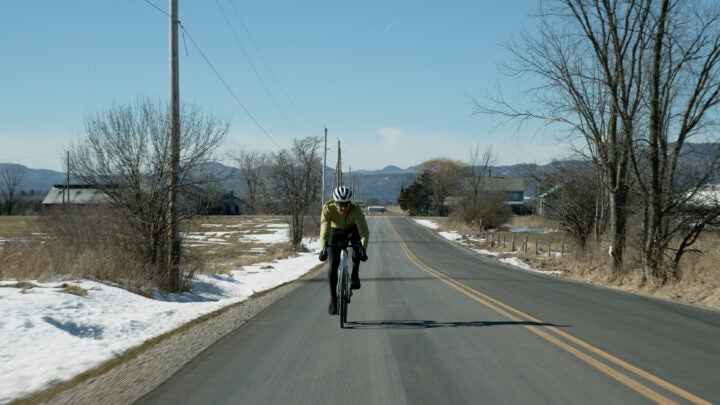
Yet, something else was happening during those first five or so years that King was experiencing so much success in gravel — the discipline was also having its own heyday. More retirees from the WorldTour were joining the start lines, and cross-country mountain bikers in particular were showing great promise on dirt roads.
With the growth came what King calls a “swell of seriousness.” At first, it was disorienting. Now, King has a plan for it.
“In 2024 I plan to take the same level of seriousness that I used in the WorldTour and bring that to contemporary gravel,” he said.
Over the winter, King has been training with a coach (for the first time in nine years), working with a nutritionist (for the first time in 14 years), and using a strength coach (for the first time ever). He’s been riding hard through the cold, wet, muddy Vermont winter.
His most ambitious goal is to do well at Unbound Gravel , the race he last won in 2018. He realizes that neither he, nor the race, is the same.
“To do well over an eight-year expanse, that would be huge,” King said. “Recognizing that the level of competition is through the roof. How the race is raced is totally different.”
Read also: Dot watchin’ the Divide
The past few years have been challenging for King on the bike. In 2021, he crashed at Big Sugar Gravel, sustaining a complicated elbow injury. Then, he suffered a pulmonary embolism and had to learn how to live on blood thinners. In 2023, King came back and decided to experiment with ultra distances. He did not finish two races that he started, Unbound XL and the Tour Divide.
All of these experiences have brought him to where he stands now, which he says is a position of great privilege.
“I’m trying to keep up with the times,” he said. “I’d be doing a disservice to the position I’m in unless I embrace the support of my sponsors, unless I go to events and throw myself at that support.”
Popular on Velo
>", "path": "https://velo.outsideonline.com/news/team-car-hits-cyclist-french-junior-national-championships/", "listing_type": "recirc", "location": "list", "title": "team car hits cyclist in french junior national championships"}}'> team car hits cyclist in french junior national championships, >", "path": "https://velo.outsideonline.com/gravel/gravel-racing/watch-mathieu-belanger-barrettes-tktk-gaspesie-tktk-in-eastern-canada/", "listing_type": "recirc", "location": "list", "title": "watch: mathieu bélanger-barrette’s gravel traverse of eastern canada’s gaspé peninsula"}}'> watch: mathieu bélanger-barrette’s gravel traverse of eastern canada’s gaspé peninsula, >", "path": "https://velo.outsideonline.com/road/road-racing/cavendish-rediscovers-mojo-stelvio-snowed-in-pogacar-being-too-greedy/", "listing_type": "recirc", "location": "list", "title": "cavendish rediscovers mojo, stelvio snowed in, pogačar being too greedy"}}'> cavendish rediscovers mojo, stelvio snowed in, pogačar being too greedy, >", "path": "https://velo.outsideonline.com/road/road-gear/spotted-new-sram-red-axs/", "listing_type": "recirc", "location": "list", "title": "spotted: new sram red axs ridden to itzulia women victory by demi vollering"}}'> spotted: new sram red axs ridden to itzulia women victory by demi vollering, an american in france.
What’s it like to be an American cyclist living in France? Watch to get professional road cyclist Joe Dombrowski’s view.
Related content from the Outside Network
One way south, mountain bikers react to their first taste of non-alcoholic craft beer, video review: bmc urs 01 two gravel bike, kiel reijnen vuelta video diary: the painful decision to abandon.
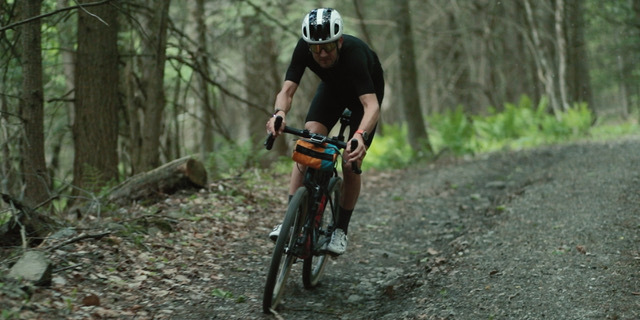
King of the Ride
https://feed.podbean.com/iamtedking/feed.xml

Welcome to King of the Ride, hosted by Ted King. A professional road racer turned gravel, I sometimes win bike races, but more than anything it‘s the gravel community that makes me happy. Slinging maple syrup, leading rides, hosting camps, and just enjoying life on two wheels, I now have the chance to chat with athletes, entrepreneurs, and all walks-of-life who love the bicycle. Hop on board and please enjoy the ride!
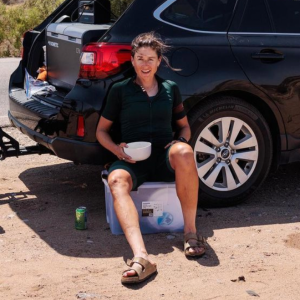
Wednesday Jun 07, 2023
Episode 111: Lael Wilcox and the 2023 Tour Divide
On the eve of Tour Divide, I thought it would be wise to talk to the friendliest character in bikepacking, Lael Wilcox. We caught up with Lael on her ride TO THE START of the Tour Divide, as she rides from Tucson, Arizona to Banff, Alberta, Canada.
There are loads of questions on my mind as it seems like this event is intentionally cryptic. For example, the Tour Divide is a ride along the Continental Divide Trail... which is also called the Great Divide... which starts in Banff... unless you consider the start in Jasper, Alberta... and the route usually stays the same... but sometimes changes year to year?
I'll be relying on Athletic Greens to seek daily nutrition thanks to AG1 all throughout my ride. If you're interested in trying Athletic Greens visit www.drinkAG1.com/tedking to get on the fast track to simplified nutrition!

Comments (0)
To leave or reply to comments, please download free Podbean iOS App or Android App
No Comments
To leave or reply to comments, please download free Podbean App.

SORT CONTENT BY LOCATION
CLICK TO DRILL DOWN BY COUNTRY/PROVINCE
Your browser is ancient! Upgrade to a different browser or install Google Chrome Frame to experience this site.
Inspiration
- Bikepacking 101
- Join/Support

- View Latest/All
- Bikepacking Videos
- Your Stories
- Rider's Lens
- Field Trips
Popular Tags
- #bikerafting
- #Tour-Divide
- #family-bikepacking
- #winter-bikepacking
- #1Q5V (1 Question 5 Voices)
Gear/Reviews
- Bikepacking Bags
- Camping Gear
- Accessories
- #Editors-Dozen (Our Favorite Gear)
- #Gear-of-the-Year
- #MYOBG (DIY)
- #Decade-in-Review (Best of All Time)
The Gear Index
Latest indexes.
- Mini Panniers
- Saddlebags & Top Openers
- Cargo Cages & Anything Bags
- Gravel Bars
- Drop Bar 29ers
Bikepacking Bikes
- Rigid & Plus Bikes
- Drop-bar & Gravel
- Full Suspension
Rigs & Roundups
- Rider & Rig
- Race/Event Rig Roundups
- Worthy Builds
- Handbuilt Bikes
- #29+ (29-plus)
- #vintage-mountain-bikes
- #cargo-bikes
- Readers' Rigs (Dispatch)
- New Bikes (Dispatch)
Plan Your Trip
- Bikepacking Guides
- Bikepacking Food
- Gear & Pack Lists
- Bike Photography
Essential Reading
- Leave No Trace (for Bikepackers)
- Guide To Bikepacking Bags
- Bikepacking Gear That Lasts
- #Bikepacking-Awards
- Power Of An Overnighter
- Advice For New Bikepackers
- Our Favorite Bikepacking Routes
-
Where to Begin
We have over 300 original and curated bikepacking routes in our global network spanning nearly 50 countries.

Start at our worldwide routes map to dig into our detailed guides with GPS maps and inspiring photography.
By Location
- The United States
- Latin America
- Middle East
By Length (days)
- Overnighters & S24O
- Weekend Routes (2-4)
- Week-long Routes (5-10)
- Odyssey Routes (11-30)
- "Freakouts" (31+)
Local Overnighters
The Local Overnighters Project is a unified effort to document and map one-night bikepacking routes all over the world—by locals, in their own backyards.
The Bikepacking Journal is our biannual printed publication. Each issue features a collection of inspiring writing and beautiful photography. Find details on the three most recent issues below, join the Bikepacking Collective to get it in the mail (anywhere in the world), or click here to find a collection of selected stories in digital format.

The special edition 10th issue of The Bikepacking Journal is one you won’t want to miss! It features 25% more pages with extra stories, bonus art and maps, and much more...

Issue 09 takes readers on trips through time—one to the early days of bicycles—and offers several reminders to be grateful for supportive friends and family, and strangers we meet along the way...

For Issue 08, we invited several contributors to return and pick up where earlier trips and ideas left off and also feature a handful of first-timers whose perspectives we’ve long been eager to share...

2023 Tour Divide Debrief (Days 1-2.5)

Previous Dispatch From Fri Jun 9, 2023
Friday Debrief: Supertramp Frame Bags, Bikepacking Annapurna, Meerkat Klunker, and More…

Despite being slowed down by wet dirt roads and muddy conditions, the riders at the front of the 2023 Tour Divide are picking up speed. Leader Ulrich Bartholmoes recently passed Mike Hall’s 2016 record dot, and Lael Wilcox is ahead of her own women’s record. In our first 2023 Tour Divide Debrief, we take a look at what’s happening at the front of the race, share a couple of video updates from Josh Ibbett, and take a look at Alex Howes’ Lab71 Tour Divide Bike…
Several riders came out of the gate fast on Friday, including favorite Ted King, who settled in up front of field and is riding incredibly fast. However, Ted spent two nights indoors, taking long recovery breaks off the bike. This set him back behind the current leaders but could be a long-game strategy.
On the flip side, leaders Ulrich Bartholmoes and Justinas Leveika have been operating on very little to no sleep and leapfrogged one another throughout day one and two. Despite the bad weather, the two put up nearly 280 miles in the first 24 hours. Leader Ulrich Bartholmoes described night one on his instagram account, “What a terrible night! From Koko Claims at km 160 it rained non-stop and it was extremely muddy. The mud-clogged gears made riding really difficult and exhausting. And with the brutal climbs and the cold of the night I suffered quite a bit. Now Justinas and I are leapfrogging each other, we rode through the night without any sleep break and got a good lead on the guys chasing us.”
Ulrich is currently in the lead and recently passed Mike Hall’s 2016 record dot on the Trackleaders map, which is pretty impressive. He’s averaging about 10.26 MPH (16.5 KPH), including stops.
In the women’s race, fan favorite Lael Wilcox currently has a strong lead over next in line Katya Rakhmatulina. Lael has been playing leap frog with her own record dot all morning. She’s averaging about 8.8 MPH (14.2 KPH) including stops.
In other news, first-place northbound rider Andrew Kulmatiski just made this dreadful announcement, which is really sad to see. We hope the situation is resolved and will share an update when we know more.

For further updates, be sure to check out Josh Ibbett’s detailed videos chronicling the first two days below:
In his latest video update, ultra-endurance racer Josh Ibbett breaks down all the action from day two in his own style, discussing sleep strategies and his own knowledge of the course.
…and here’s his update from day one.
Alex Howes’ Rig
In other news, Cannondale recently published a video documenting Alex Howes’ Tour Divide LAB71 Topstone, complete with a suspension fork. Alex started the race looking good but had a broken spoke and a sidewall tear that caused him to leave the course to get repairs. It appears he’s back in action now.
FILED IN (CATEGORIES & TAGS)
Please keep the conversation civil, constructive, and inclusive, or your comment will be removed.
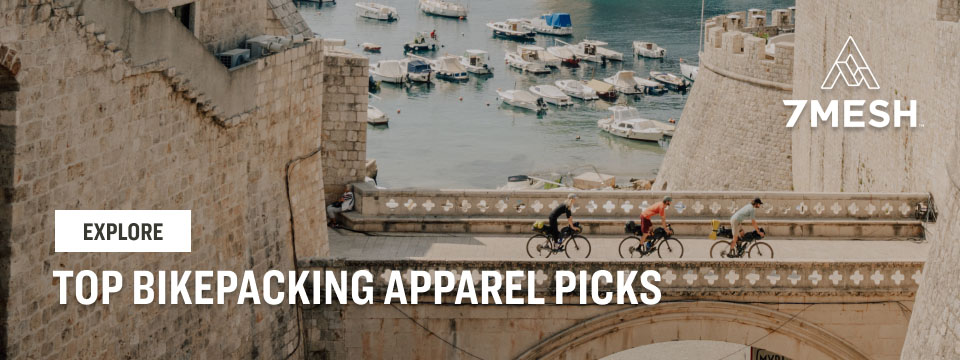
Rad Companies that Support Bikepacking

You need to be logged in to use these features. Click here to login , or start an account if you’re not yet a member of the Bikepacking Collective…

‘You Can See the Hate In His Face': Steve Harvey Gives Bernie Mac a Dirty Look During 'Kings of Comedy' Promo Tour In Resurfaced Clip
R umors of turmoil between Bernie Mac and Steve Harvey ‘s working relationship have circulated in Hollywood for years. Fellow comedians and insiders, including Katt Williams , suggest that the dynamic between the two was fueled by competition and perhaps jealousy on the part of the “Family Feud” host.
Now an old video of the two comedians promoting the “Kings of Comedy” tour has resurfaced, sparking speculation on social media about Steve’s feelings toward the star of “The Bernie Mac Show.”
In a resurfaced clip posted by @Iam_big_bankz, Bernie is delivering a joke during a radio interview, with a young Cedric The Entertainer cracking up and D.L. Hughley seeming to be concentrating on the joke.
Steve, however, is seen on the side with what looks like a sour face. While the excerpt is possibly out of context, social media detectives say the evidence is clear: In the clip “Steve is hating hard.”
Others also chimed in.
“U can see the hate in his face,” one person wrote. Another person added, “Ohh shiiii, it’s all out of the box now [two laughing emojis] Steve has some explaining to do.”
A third comment read, “Steve over there figuring out which jokes he is going to steal.” A fourth online user said, “They knew Bernie was the ONE !!!!”
To some, the short clip appears to show Harvey’s “envy, jealousy and hate” for Mac, including one person who said, “To me, it looks like he was just looking at Bernie.”
Some people who saw the original footage claim the camera was cut before Steve got a chance to laugh. They believe the video was edited to fuel the “narrative” about their beef. “Yup. Steve Harvey always looks like this, but you know… divide and conquer.”
Still, multiple comedy insiders have publicly spoken about the “Think Like A Man” author’s true feelings about Bernie from their perspective.
D.L. said during his interview with DJ Vlad in 2018 that the beef between Steve and Bernie stopped a sequel from being done. According to the fellow “Kings of Comedy” star, Steve was the top dog and was getting a lot of mainstream success, “and then Bernie started to get it,” which became a problem.
The third “King of Comedy,” Cedric claims they pushed through their differences on the original tour but the tension blocked them from doing a second comedy tour.
“They both alpha males. They both…they just saw it different,” he explained. “But at the end of the day, they was able to get through it.”
Radio personality Ed Lover confirmed the tension when he heard that Steve wanted Bernie’s role in “Ocean’s Eleven” and even told the producers he was willing to take less money to play the role of Frank Catton.
“All I can say is what Bernie told me,” the “Yo! MTV Raps host” said during an interivew on “The Culture Club Uncensored.” “And he was upset with Steve because he said Steve tried to get him taken off of Ocean’s — the Ocean’s movie he did … and tried to vie for his part after he already got hired. And, uh, Bernie never lied to me. That’s all I’m going to say. He was my friend. I loved him.”
Katt took it a step further in his interview on Shannon Sharpe’s “Club Shay Shay” podcast. He claims he turned down the chance to do “Kings of Comedy 2” because of the way that Steve “s—ted on Bernie.”
The “Pimpin’ Pimpin’” comedian said Steve started a narrative that he went last because he was funnier than Bernie. According to Katt, Steve didn’t share with many that it was his tour and that was why he ended the show.
“The reason you were supposed to go last because it was your tour, tell the truth,” he said. “It was Steve’s tour… These are the guys opening for him. Of course, you got to close if it’s your tour.”
Until “he humbles himself,” Katt said Steve will forever be “kinged by the king” Mac.
“That man was funnier than all of y’all and y’all thought y’all had one over on him,” he explained. “You thought he was black and ugly and you were good looking and he couldn’t make it because you did … and that ain’t the way comedy work. The king is the funniest.”
Bernie Mac’s daughter, Je’Niece McCullough, that she knew that the industry was cutthroat and that people just didn’t get along during a video taken while on Instagram Live.
She said that her dad knew that a lot of people didn’t like or appreciate him, giving her this tidbit of advice: “If you ever want to be loved by anyone… If you ever want to be special … just die.”
Bernie Mac passed away on Aug. 9, 2008, which was about eight years after the conclusion of the “Kings of Comedy” tour. He was 50. The tour ended in early 2000, marking the last time Steve and Bernie worked together.
‘You Can See the Hate In His Face’: Steve Harvey Gives Bernie Mac a Dirty Look During ‘Kings of Comedy’ Promo Tour In Resurfaced Clip
![Rumors of turmoil between Bernie Mac and Steve Harvey‘s working relationship have circulated in Hollywood for years. Fellow comedians and insiders, including Katt Williams, suggest […] Rumors of turmoil between Bernie Mac and Steve Harvey‘s working relationship have circulated in Hollywood for years. Fellow comedians and insiders, including Katt Williams, suggest […]](https://img-s-msn-com.akamaized.net/tenant/amp/entityid/BB1lEdFR.img?w=768&h=432&m=6&x=189&y=107&s=666&d=231)

IMAGES
VIDEO
COMMENTS
The Tour Divide. My 2023 Tour Divide packed a punch. There was good, bad, ugly, plus lots in between. Given how much time, effort, energy, and resources went into it, I wanted to document a good portion of it so that I could possibly benefit from it if I decide to give it another go, and for others to get a hand-up from my experience.
A first-time Tour Divide participant narrowly missed setting the race's course record last week, while the final spot on the women's podium came down to an almost-sprint after more than 18 days of racing. ... Jens Van Roost, and WorldTour pros turned gravel privateers Ted King and Alex Howes. As the race crossed Montana, Idaho and Wyoming ...
UnTapped co-founder, Ted King, recently went for a very long bike ride. A nearly 750 mile bike ride, in fact. His goal, however, was the 2,700 mile Tour Divide, a self-supported bikepacking race from Banff, Alberta, Canada to Antelope Wells, New Mexico at the border of the United States and Mexico. By not reaching the finish line, this trip ...
The 2023 Tour Divide begins on Friday, June 9th, at 8 a.m. with around 200 riders following the roughly 2,700-mile Great Divide Mountain Bike Route from north to south starting in Banff, Alberta, Canada, and finishing at the US/Mexico border in Antelope Wells, New Mexico. The current record was set back in 2016 by the late Mike Hall (13 days ...
Welcome to my daily coverage of the 2023 Tour Divide. The Tour Divide is a 2700mile bikepacking race traversing the length of the USA. The Tour Divide starts...
From Grand Tours to the backcountry roads stretching from Canada to Mexico, join Alex Howes as he tackles the Tour Divide, a self-supported ultra-endurance b...
We're exactly four days in on the 2023 Tour Divide. Race leaders Ulrich Bartholmoes and Justinas Leveika finally stopped for a relatively long rest this morning at Elkhorn Hot Springs in southwestern Montana. ... Vermonter Ted King shouldn't be discounted, despite being 100 miles behind the leader. Ted's 12.1 MPH average speed is nearly ...
Episode 112: My [Ted King] Tour Divide Recap with Guest Host Rebecca RuschWhen was the last time you did something that really pushed your limits? That was less enter-the-dragon and more face-your-own-dragon?Ted King took on the Great Divide Mountain Bike Route. During his expedition, he had to push himself to his ultimate limit.Rebecca reached out to Ted about his journey because She knows ...
One of the 2023 Tour Divide's fastest starters, former WorldTour road pro Ted King, ultimately dropped out of the race after experiencing the extreme end of muscle damage. Although King is an exquisitely fit elite athlete with lots of experience with the intensity of road racing, he'd done few multi-day ultra endurance events where ...
For those unaware, the Tour Divide is a self-supported race that follows the 2,700-mile Great Divide Mountain Bike Route, which starts in Banff, Alberta, Canada, and finishes in Antelope Wells, New Mexico, on the US/Mexico border. ... Ted King. If you're into the gravel scene, you've likely heard of the 40-year-old from Vermont. Before ...
Results for Tour Divide - This year's Tour Divide was heavily affected by the rains and mud, with the three leaders taking shelter in a public toilet for 12 hours at one point. Ulrich Bartholomoes held off Justinas Leveika and Joe Nation to take one of his first off-road wins. ... Ted King: SOLO: MEN:
The Tour Divide is a 2700+ mile nonstop race the length of the Rockies, from Canada to Mexico. When the clock starts, you start riding, and it's a test of se...
It's a question that Ted King has been pondering lately. He's not quite ready for the answer. After his first retirement — from the WorldTour in 2015 — King became an early adopter of gravel racing, a then-nascent off-road discipline. He won Unbound Gravel in 2016 and 2018 and had good results at other events, including a win at SBT ...
Episode 111: Lael Wilcox and the 2023 Tour Divide. Wednesday Jun 07, 2023. On the eve of Tour Divide, I thought it would be wise to talk to the friendliest character in bikepacking, Lael Wilcox. We caught up with Lael on her ride TO THE START of the Tour Divide, as she rides from Tucson, Arizona to Banff, Alberta, Canada.
Ted King. @iamtedking. Prepping for Unbound XL with Tour Divide is like a grand tour. I'm lucky to be able to focus on the macro — family, bike, work. The juggle is real! @InsideTracker. is a helpful daily tool I use to ensure I'm at my best for all of it.
Friday Debrief: Supertramp Frame Bags, Bikepacking Annapurna, Meerkat Klunker, and More…. Despite being slowed down by wet dirt roads and muddy conditions, the riders at the front of the 2023 Tour Divide are picking up speed. Leader Ulrich Bartholmoes recently passed Mike Hall's 2016 record dot, and Lael Wilcox is ahead of her own women's ...
Ted King is planning to ride 2023 Tour Divide. Ted shared during the recent Payson McElveen podcast. Tour Divide Race: Gear, Advice, Tips, Pics, Chat, Training | Ted King is planning to ride 2023 Tour Divide
The third "King of Comedy," Cedric claims they pushed through their differences on the original tour but the tension blocked them from doing a second comedy tour. "They both alpha males.